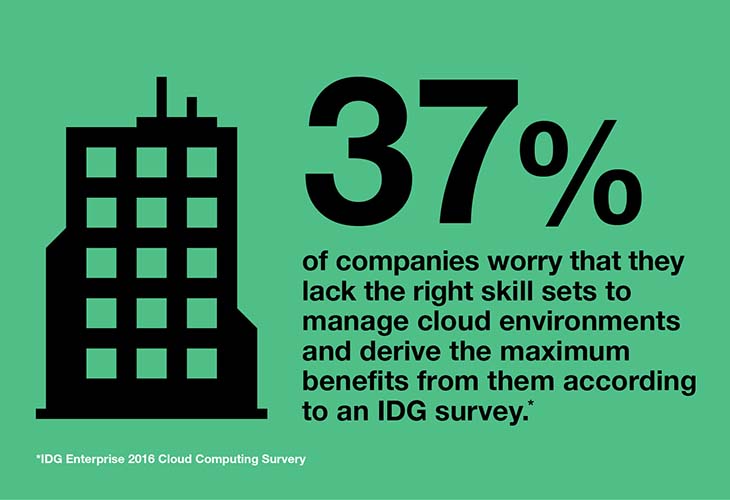Multi-cloud enables best-in-class sourcing, avoids vendor lock-in and helps enterprises control costs. According to market research firm IDC, multi-cloud is being driven by digital transformation, where IT departments are expected to deliver a diversity of highly-scalable resources that span business functions. As a result, IDC predicted last year that more than 90 percent of enterprise IT organizations would commit to multi-cloud architectures by 2018. Its forecast is on track.
Multi-cloud does what it says on the tin. It uses multiple clouds from multiple providers to address multiple applications. Development and testing may be in one cloud and the production environment placed in another cloud. Enterprises are mitigating risk by not relying on one provider. Multi-cloud enables enterprises to select data centers in regions close to their users or customers, minimizing latency and enhancing the user experience. With these benefits, however, come trade-offs.
Cloud providers may offer their own management platforms, but these focus on their own services. IT departments must manage numerous interfaces, which makes it costly, time consuming and difficult to troubleshoot.
A new view of cloud management
Multi-cloud demands enterprises re-think the way things are managed. The complexities created by multi-cloud magnify the traditional challenges that IT faces, including migration, visibility, security, performance and automation.
“There is a complexity in assessing what is available against other cloud providers, especially as more functions are being employed every day, such as analytics and the Internet of Things (IoT),” explains Alexis Dupuydauby, Cloud Professional and Managed Services Marketing Director for Orange Business.
A multi-cloud strategy suits a number of enterprises, according to Dupuydauby: large enterprises looking to avoid lock-in syndrome; companies consolidating IT departments; firms going through mergers and acquisitions; smaller companies that want the flexibility of multi-cloud offers; and multinationals requiring local data centers due to compliancy, latency and security issues.
 “Each case is different, but few have the in-house resources to reach their multi-cloud goal, and they require a partner to help them manage complexities efficiently,” Dupuydauby says. Orange Business has developed a professional services catalog that customers can pick and choose from, according to requirements. These include audits, migration, strategy planning, assessments and service optimization, plus a full set of industrialized services.
“Each case is different, but few have the in-house resources to reach their multi-cloud goal, and they require a partner to help them manage complexities efficiently,” Dupuydauby says. Orange Business has developed a professional services catalog that customers can pick and choose from, according to requirements. These include audits, migration, strategy planning, assessments and service optimization, plus a full set of industrialized services.
Multi-cloud may represent an increased challenge for development teams. They have to learn how to integrate applications within the multi-cloud infrastructure. The development team may have to re-write application elements or create multiple versions of an app to meet multiple cloud requirements. The Cloud Management Platform may be the appropriate solution, but then enterprises need the right skills to choose, design and maintain these in order to meet user and developer demands, which are continuously adjusted to new services offered by cloud providers.
Once the app is up and running, the DevOps team faces another complex situation: that of managing the performance of the app. Just like developers, they need to understand the differing APIs and standards that cloud vendors use.
Multi-cloud service management addresses the integration challenges that these teams face. Orange, for example, has solution and transformation labs to help DevOps and provide training to get internal teams up to speed on specific cloud services. Orange can also support customers with cloud management platforms, including a custom implementation to abstract management complexity.
Network integration is another concern. “Networks have to be properly connected with security between the cloud and solutions,” explains Dupuydauby. “This isn’t easy and needs a carefully mapped out multi-cloud management strategy, which is where a vendor agnostic partner can help.”
“After integration, enterprises must not forget that they will need a cloud architect internally, someone who can define the proper cloud architecture that will support services from provider A, interconnected with provider B,” adds Dupuydauby.
Securing clouds
Securing applications is more difficult in a multi-cloud environment – there is a larger attack vista. Management is complex. Each cloud service provider may have a different policy, all of which needs to be managed.
“When spreading data over multiple clouds, enterprises need to be cautious. They should have professional security in place to monitor and assess – ensuring consistency and relevance in data management,” explains Dupuydauby. Orange, for example, offers consultancy on the General Data Protection Regulation (GDPR) to ensure enterprises can track their data in the cloud and remain compliant.
“Compliance and security are difficult to manage across multiple clouds. We have strict identity access management tools globally to make sure that the governance of the cloud services’ management is aligned with the company’s security rules,” adds Dupuydauby.
The talent drought
Cloud engineers, architects, DevOps and developers in the cloud space are in short supply. Finding the right people to work on multi-cloud magnifies management challenges.
In the Microsoft Cloud Skills report last year, 83 percent of IT leaders in the UK polled said that cloud skills were important or critical to their organizations. Over one-third cited difficulties in recruiting cloud talents, and the situation is only getting worse. A trusted multi-cloud management service provider can bridge the skills gap, bringing expert knowledge.
The big transition
Transitioning an IT infrastructure to cloud is a huge task. “A multi-cloud management service provider can take over the operations management on behalf of the customer and ease the complexities,” says Dupuydauby. “We take an a la carte approach. Customers decide what they want us to manage and what they want to keep in house. It very much depends on their maturity and workloads.”
Multi-cloud demands multi-contract management, strong governance in setting up service catalogs and a single portal to manage the multi-cloud estate. “This is why enterprises must be open-minded about multi-cloud management. By relying on a third party to manage these elements, IT can focus on choosing the right services and establish security and governance rules that will push the business forward – rather than spending time on managing service providers,” concludes Dupuydauby.
Find out more about the essential management of a multi-cloud model in our Create a cloud experience your business can depend on ebook.
